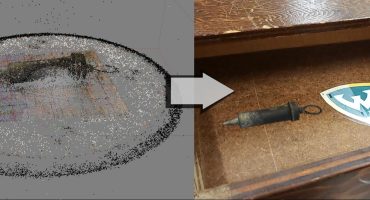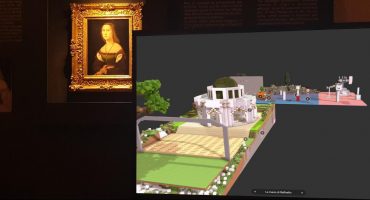About
 Charlotte Sargent demonstrating and explaining photogrammetry to Bolton Libraries and Museums staff during an in person visit to the museum (photograph by Bolton curator Ian Trumble)
Charlotte Sargent demonstrating and explaining photogrammetry to Bolton Libraries and Museums staff during an in person visit to the museum (photograph by Bolton curator Ian Trumble)The UK North West Photogrammetry Hub (NW Hub) is a collaborative knowledge exchange network of researchers, curators, museum professionals and students looking to upskill multiple heritage sector organisations in the region. More than 100 people across 20+ heritage and science institutions and organisations got involved in the NW Hub in 2021 to receive training in the creation and use of virtual 3D models. We’re launching our first collection of models in a virtual museum and we’d like to share our story, we hope you enjoy!
This is a fly through of the NW Hub virtual museum model.
People
Ardern Hulme-Beaman — Ardern is originally a zooarchaeologist/ecologist who studies differences in shape between populations of animals. He got into digital humanities through the desire to build and share his expertise in photogrammetry and love of visiting museums for data collection. To this end he founded and set up the University of Liverpool Photogrammetry Team and the NW Hub, which aimed to build digital 3D skills in students and bring them to museums for experience and research. He also plays the uilleann pipes (Irish bagpipes), which appear in the exhibition amongst the curators’ personal items in the Social History section.
Charlotte Sargent — Charlotte is originally an Egyptologist researching the written expression and social context of ancient Egyptian friendship. She has worked in the Garstang Museum of Archaeology as both a volunteer and a curatorial assistant, which led her to getting heavily involved in photogrammetry. Charlotte was the lead technician in the Art Fund funded portion of the NW Hub for all of 2021 and led training museum professionals and volunteers. She photogrammetried her lucky robin for the curators’ personal items in the Social History section.
Background
The network was born out of Ardern’s work to train and bring students to museums to expand their knowledge and experiences in digital heritage. To this end, Ardern founded a photogrammetry working group at the University of Liverpool in 2017. Photogrammetry is relatively easy to pick up, but advanced skills are best developed with a lot of trial and error (mostly error!). A central ethos in the university working group was non-hierarchical knowledge exchange whereby students would learn to train newcomers in the basics. Students would then develop and integrate into wider team projects to trail and formulate efficient protocols for advanced model building (complex structures, shiny objects, image enhancement etc.—check out this dancing hippo model by undergrad Kaitlyn McGann for international day of dance in 2019. We wanted to extend this approach to learning and skills development by bringing it to people working in the heritage sector in the NW of the UK.
The Project
Photogrammetry, the creation of virtual 3D models from multiple 2D photographs, provides a hugely accessible and useful tool for the heritage sector to digitally record collections, make them more accessible and draw in new audiences. Photogrammetry presents a number of hurdles to many museums, particularly small local ones, as gaining sufficient skills and building computer infrastructure to support digital 3D activities is a challenge and can be costly. By building a collaborative knowledge exchange hub it’s possible to share experience and resources.
 Charlotte Sargent helping Marie Kosnes Lindseth, University of Liverpool student, with photogrammetry of a cat cranium. (Photograph by Ardern Hulme-Beaman)
Charlotte Sargent helping Marie Kosnes Lindseth, University of Liverpool student, with photogrammetry of a cat cranium. (Photograph by Ardern Hulme-Beaman)Covid created significant challenges and unexpected opportunities for our original student group. It put a complete stop to all student activities initially and some of the most experienced team members graduated without being able to pass on their knowledge to the next cohort, but it also opened up a multitude of funding opportunities for this kind of project. The models the team built were in high demand and were added to Sketchfab teaching collections within both the University of Liverpool and also several other UK and international universities. Digital 3D models offer a richer experience than in-person object handling alone. It is often possible to zoom into 3D models of objects and examine them in great detail and at high resolution in a way that in-person handling could only replicate with cumbersome and difficult-to-use magnification equipment. It’s also possible to handle virtual objects more freely than physical objects. Additionally, digital tools open up a whole range of other analytical opportunities; for example, by applying image enhancement techniques and examining objects without their textures, it can become easier to identify things like cracks and moulding lines.
To support an active and growing team in building such models for multiple museums requires a lot of equipment. It can also be challenging and expensive for museum professionals to be involved in these activities. We used the viewer numbers on Sketchfab along with the Garstand Museum’s pre-Covid in-person visitor numbers to demonstrate the demand for digital 3D content and the usefulness of it on a platform like Sketchfab. In late 2020, we were awarded the Art Fund Respond and Reimagine grant through the support of the Garstang Museum and Dr Gina Criscenzo Laycock to set up a formal training programme for museum professionals and volunteers in 2021.
The project was somewhat turbulent to begin with; UK Covid lockdowns were sporadic and unpredictable and we had to change our plans to deal with this. We flipped between focusing on creating online teaching content and developing in-person training activities. Ultimately, after surveying possible participants, we found an overwhelming demand for in-person training. Despite being a highly digital activity—and there are already many and diverse online materials to learn it—photogrammetry is still a skill that people like to learn in person, with the freedom to explore and ask questions without the burden of shared screens and microphone noise (and the distractions of pets!). We therefore set up small group photogrammetry workshops where we provided intense instruction to museum professionals over the course of a day. Participants brought their own objects or would photograph one of the artefacts or objects we had to scan in our labs. Between May and August 2021 we trained ~40 people this way, building relationships (and models!) with multiple museums and demonstrating the potential of 3D digitization. These were often some of the most rewarding models to build, with people bringing in objects of personal significance to be preserved in 3D or even just a child’s toy as they rushed out that morning. We included these in the virtual exhibition as personal items in the Social History section. By September/October 2021 Covid vaccination programmes were gaining momentum and we were finally able to take on larger workshops in museums.
We ran several in-house museums training visits to museums in Rochdale Touchstones, Bolton Museum, Lancaster Museums, Fleetwood Museum, the National Waterways Museum in Ellesmere Port, the Williamson Museum and Art Gallery in Birkenhead, and Tullie House Museum in Carlisle. Assisted by small groups of highly trained students, we set up 3–4 workstations for participants to work at; this approach had the benefit of allowing participants to digitize objects that they might not have been able to bring to our labs when they came to us. Students instructed museum professionals in the basics while Charlotte and Ardern moved between workstations to address technical questions or outline how completed models might be used. The UK NW is rich in cultural heritage, with objects of international importance but also of local historical significance; as a result we were extremely privileged to build models of ancient Egyptian artefacts (Bolton Bes) and also British Industrial Revolution objects (Corn Law Jug) at the same time. And of course, we can now share them with everyone via Sketchfab.
The Future
The great benefit of this mass upskilling project for the digital heritage industry is that it has sparked people’s imaginations. Heritage professionals who participated in the trainings often reported having gained a better understanding of both the potential and the limitations of digital 3D in their collections. So, although not everyone we trained will go on to build models themselves, they are thinking of ways to use such technology in the future. Many of the students involved have implemented the skills directly into their work, and have also established mutually beneficial contacts with other museum professionals. This means that future generations of graduates will have a range of skillsets that senior museum professionals will desire and, most importantly, understand how to integrate into existing systems, thereby maximising their potential.
Our favourite model
One of our favourite models and the inspiration for our work has to be Josep Giribet’s Canon Mulet’s Mausoleum animated reconstruction model.
This engaging model encapsulates so much of the benefits and strengths of photogrammetry and digital 3D heritage. It captures an episode in the object’s life (though an unfortunate one!) and demonstrates how digital 3D methods might help preserve such structures in the future. It also brings to life the monumental effort that goes into restoring such artefacts when they are damaged like this; there are dozens if not hundreds of pieces in Canon Mulet’s Mausoleum that need to be conserved and restored to make the object whole again. The animation is not only highly complex with many moving parts, but also beautifully simple in its final goal to show the audience the complete structure from a mass of small fragments.



